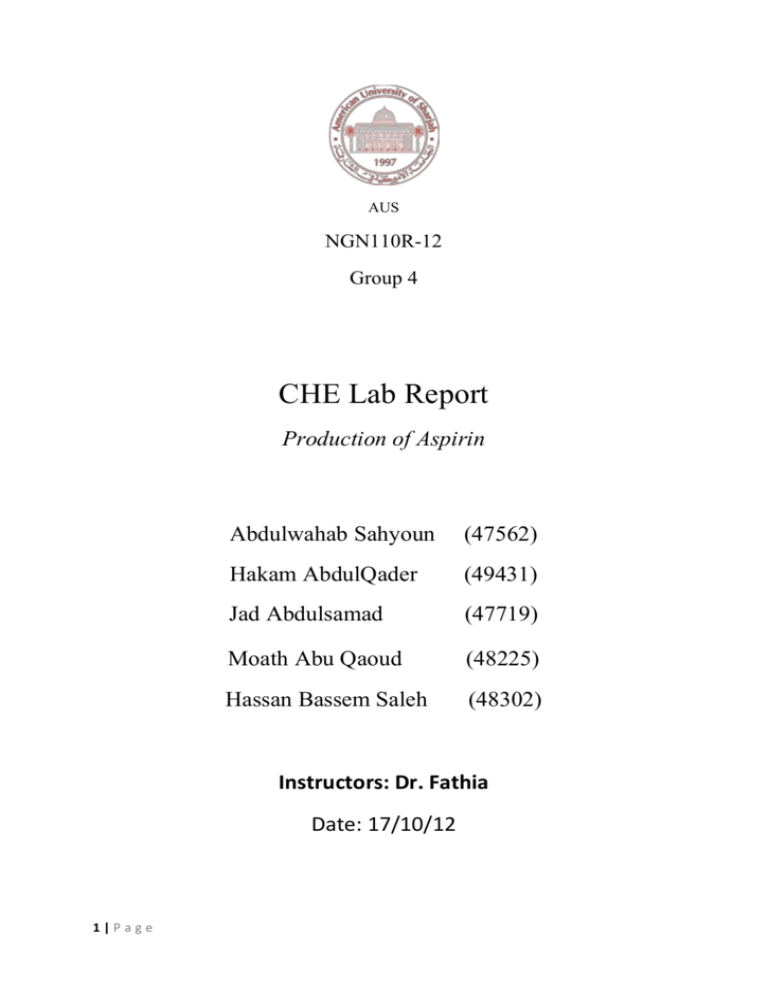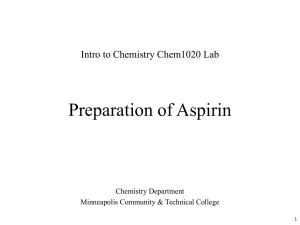CHE Lab Report
advertisement

AUS NGN110R-12 Group 4 CHE Lab Report Production of Aspirin Abdulwahab Sahyoun (47562) Hakam AbdulQader (49431) Jad Abdulsamad (47719) Moath Abu Qaoud (48225) Hassan Bassem Saleh (48302) Instructors: Dr. Fathia Date: 17/10/12 1|Page Abstract People experience severe pains as they age, some of these symptoms may become fatal overtime. Such symptoms include: Arthritis, strokes, headaches, swelling, and inflammation. These conditions are considered very painful and were hard to cure back then. Thanks to the German chemist, Felix Hoffman, in 1897 a drug known as acetylsalicylic acid was discovered and synthesized [1]. This chemical also known as Aspirin nowadays is synthetic compound used medically to cure headaches, minor aches, slight fevers and the malleability of blood in our heart. Aspirin is mostly used as a pain reliever to whoever is in need. This week’s chemistry lab we learned what does aspirin consist of and the raw materials used to produce such prescription. The production of this drug requires a variety of chemicals, which are (Salicylic acid, Acetic Anhydride, Ethanol, Sulphuric Acid, Ferric chloride). To complete this procedure not only we need chemicals but also tools to perfect it and be safe for usage by the patients, such as (large test tube, watch glass, Buchner funnel, filtering flask, filter papers). 2|Page Table of Contents Abstract ...................................................................................... 2 Introduction ................................................................................ 4 Results ........................................................................................ 5 Discussion of Results.................................................................. 6 Conclusion .................................................................................. 7 References ................................................................................... 8 Appendix ..................................................................................... 9 3|Page Introduction Chemical engineering is the branch of engineering that discusses problems concerning food and medicine production as well as the design and operation of instruments that solve problems and make useful consumer products through a series of chemical reactions. Chemical engineers are able to perform tasks mainly involving petroleum refining, crude oils, and recycling, as well as the manufacturing of consumer products such as cosmetics, food, detergents, and ceramics. In this report we will be discussing the production of Aspirin and its main uses. Aspirin production is a series of chemical reactions and takes around an hour to make. To form aspirin, 2g of salicylic acid are added to 3ml of acetic anhydride. Then, 4 drops of sulfuric acid are added to speed up the reaction. The contents are mixed and placed in hot water at a temperature of 60 degrees for 10 minutes. The solution is then placed in an ice water bath and left until crystals form [3]. These crystals will then have to go through several other processes such as filtration, drying, purification, dry screening, and compression. The steps will be explained in further detail throughout the report. The purity of aspirin is then determined by testing it with a 1% sample of iron ( III ) chloride and compared with a commercial sample of Aspirin and salicylic acid. If the Aspirin happens to be impure it will give a purple color. Aspirin has become so common that around 16000 tons of aspirin tablets is used every year in the US. and 2 billion dollars per year is spent only on aspirin. Aspirin however does not come only in tablets, it comes in other forms as chewable gum, caplets, and suppositories. The dosage concentration for a usual cardio protection is around 81 to 325 mg. For fever it is around 650 mg for every six hours depending on how strong the pain is [2]. 4|Page Results In this experiment we found out that aspirin can be produced in several steps, which begin with weighing the salicylic acid and adding the acetic anhydride to it. Next we drop about 4 drops of concentrated sulfuric acid as a catalyst to speed up the interaction, and mix everything thoroughly, then we heat the mixture for 10 minutes in a beaker of hot water, and cool it after that with ice water because aspirin is insoluble in cold water while the other reagents are not, so it'll be deposited, then we'll filter the white precipitate and wash the crude with water and allow it to dry by suction for several minutes. Finally we test the purity using the iron (III) chloride solution and this step is shown in the discussions exactly. Flow Diagram: Weigh 2.0g of salicylic acid 5|Page Add 3 mL of acetic anhydride Add 4 drops concentrated sulfric acid Mix in a beaker of water (80 - 90)° C for 10 minutes Wash the crude with 5 mL portions of cold water Filter when crude aspirin separates by suction filtration using Buchner flask Add 20 mL ice water Discussion of Results Is it a good and easy way? It's definitely an easy way since it uses only a few chemical equipments and it’s a short time experiment, and a good way because; for example it uses facts such as Aspirin is insoluble in cold water so that it'll be separated from the reagents. And it shows us how aspirin is produced exactly and makes us distinguish if it's pure or not by using iron (III) chloride solution. How to deal with impurities? Most of the times we will end up having impure aspirin, to determine this impurity aspirin is dissolved in a 1% Iron (III) chloride solution. If a purple color is observed then the aspirin s impure. Incase this happens, aspirin must go through a process known as Recrystallization. Recrystallization is similar to the beginning process; however, aspirin this time is added to ethanol and heated until completely dissolved. Once the aspirin is dissolved, the solution must be cooled again in an iced water bath [4]. After cooling the crystals formed are dried, filtered, and compared with a pure sample of aspirin. If the aspirin remains impure, then the process must be repeated until the products are pure enough. Figure 1: Pure Aspirin [5] 6|Page Conclusion Aspirin, also known as acetylsalicylic acid, is used as a drug to medically cure headaches, slight fevers and minor aches. Aspirin can be manufactured in different weights, sizes and thickness depending on the concentration of the dosage. It can also be taken in forms as chewable gum, caplets and tablets. To produce such product, there are two different production systems that can be used, by a machine or by a chemical reaction. In this experiment, aspirin was produced in a series of chemical reactions that tends to take an hour to make. The aspirin went through processes such as (weighing, mixing, heating, cooling, filtration, washing and drying). The purification, dry screening, compression, testing, bottling, packaging and quality control follow the manufacturing steps of aspirin by computer-aided machine. In the chemical reaction, most of the time the aspirin produced might be impure. Therefore, aspirin must go through another process known as recrystallization. Recrystallization is similar to the beginning process but aspirin is added into ethanol and heated completely until dissolved. Due to the fact, that an impure aspirin is more likely to occur, the process to produce such product may take even longer time to make. Not to mention, when aspirin is produced by the machine it is much more accurate, takes less time to make, faster and most importantly it’s safer. It is therefore recommended when manufacturing aspirin to use highly automated devices and to be completely computerized. Therefore, aspirin can be manufactured in batches and can be distributed easily. 7|Page References [1] Aspirin. (2012, October 11). In Wikipedia, The Free Encyclopedia. Retrieved 17:06, October 12, 2012,from http://en.wikipedia.org/w/index.php?title=Aspirin&oldid=517163091 [2] Ladyoasis.(2007). Dosage forms of aspirin [Web log comment]. Retrieved 22:24, October 12, 2012, from http://answers.yahoo.com/question/index?qid=20080330154547AAjVE0D [3] Mulchem.(2012). Aspirin Lab Part 1 Making the Aspirin.[FLV]. Retrieved 21:59, October 12, 2012, from http://www.youtube.com/watch?v=AG6ACv2F558 [4] Recrystallization (chemistry). (2012, October 1). In Wikipedia, The Free Encyclopedia Retrieved 16:17, October 15,2012, from http://en.wikipedia.org/w/index.php?title=Recrystallization_(chemistry)&oldid=515520767 [5] Tradeniger Impex Private Limited.(2005). Pharmaceutical API and Raw Material. Retrieved 20:42, October 15,2012, from http://www.indiamart.com/tradeniger/pharmaceutical-raw- material.html 8|Page Appendix Units used in the process Reactors Absorber Dryer Distillation Unit Filter 9|Page






